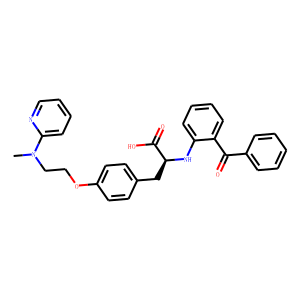| Reference | 1. Cell Signal. 2014 Apr;26(4):730-9. doi: 10.1016/j.cellsig.2013.12.019. Epub 2014
Jan 8. <br />
GW1929 inhibits α7 nAChR expression through PPARγ-independent activation of p38
MAPK and inactivation of PI3-K/mTOR: The role of Egr-1. <br />
Hahn SS(1), Tang Q(2), Zheng F(2), Zhao S(2), Wu J(2). <br />
Author information: <br />
(1)Laboratory of Tumor Molecular Biology and Targeted Therapies, University of
Guangzhou Traditional Chinese Medicine, Guangdong Provincial Hospital of Chinese
Medicine, Guangzhou, Guangdong Province 510006, China. Electronic address:
[email protected].
(2)Laboratory of Tumor Molecular Biology and Targeted Therapies, University of
Guangzhou Traditional Chinese Medicine, Guangdong Provincial Hospital of Chinese
Medicine, Guangzhou, Guangdong Province 510006, China. <br />
Studies demonstrated that peroxisome proliferator-activated receptor gamma
(PPARγ) ligands reduce nicotine-induced non small cell lung carcinoma (NSCLC)
cell growth through inhibition of nicotinic acetylcholine receptor (nAChR)
mediated signaling pathways. However, the mechanisms by which PPARγ ligands
inhibited nAChR expression remain elucidated. Here, we show that GW1929, a
synthetic PPARγ ligand, not only inhibited but also antagonized the stimulatory
effect of acetylcholine on NSCLC cell proliferation. Interestingly, GW1929
inhibited α7 nAChR expression, which was not blocked by GW9662, an antagonist of
PPARγ, or by PPARγ siRNA, but was abrogated by the p38 MPAK inhibitor SB239063.
GW1929 reduced the promoter activity of α7 nAChR and induced early growth
response-1 (Egr-1) protein expression, which was overcame by SB239063, but
enhanced by inhibitors of PI3-K and mTOR. Silencing of Egr-1 blocked, while
overexpression of Egr-1 enhanced, the effect of GW1929 on α7 nAChR expression and
promoter activity. Finally, GW1929 induced Egr-1 bound to specific DNA areas in
the α7 nAChR gene promoter. Collectively, these results demonstrate that GW1929
not only inhibits but also antagonizes Ach-induced NSCLC cell growth by
inhibition of α7 nAChR expression through PPARγ-independent signals that are
associated with activation of p38 MPAK and inactivation of PI3-K/mTOR, followed
by inducing Egr-1 protein and Egr-1 binding activity in the α7 nAChR gene
promoter. By downregulation of the α7 nAchR, GW1929 blocks cholinergic signaling
and inhibits NSCLC cell growth. <br />
2. Behav Brain Res. 2011 Jan 20;216(2):606-12. doi: 10.1016/j.bbr.2010.09.001. Epub
2010 Sep 15. <br />
GW1929: a nonthiazolidinedione PPARγ agonist, ameliorates neurological damage in
global cerebral ischemic-reperfusion injury through reduction in inflammation and
DNA fragmentation. <br />
Kaundal RK(1), Sharma SS. <br />
Author information: <br />
(1)Molecular Neuropharmacology Laboratory, Department of Pharmacology and
Toxicology, National Institute of Pharmaceutical Education and Research, SAS
Nagar, Sector-67, Punjab 160062, India. <br />
Transient global cerebral ischemia results in acute neurodegeneration in
selective brain areas. Global cerebral ischemic-reperfusion (IR) injury induced
selective hippocampal damage results into various neurobehavioral deficits
including spatial memory and learning deficiencies. In this study, we have
investigated the protective effects of a nonthiazolidinedione PPARγ agonist,
N-(2-benzoylphenyl)-O-[2-(methyl-2-pyridinylamino)ethyl]-l-tyrosine (GW1929),
against global cerebral IR injury induced neurobehavioral deficits and brain
damage in gerbils. Bilateral carotid artery occlusion induced global cerebral
ischemia in gerbils resulted in neurological deficits, hyperlocomotion, reduced
response latency in passive avoidance test and hippocampal damage. Hippocampal
neurodegeneration after cerebral IR injury was also associated with significant
increase in iNOS and MMP-9 immunoreactivity along with TNFα and IL-6 levels.
Massive apoptotic DNA fragmentation as evident from increased TUNEL (terminal
deoxynucleotidyl transferase mediated dUTP nick end labelling)-positive cells was
also observed in the CA1 hippocampal region of IR challenged gerbils. GW1929
treatment significantly ameliorated cerebral IR induced neurological symptoms,
hyperlocomotion, cognitive deficits and hippocampal neuronal damage in CA1
hippocampus region in gerbils. Significant reduction in IR injury induced iNOS
and MMP-9 immunoreactivity, TNFα and IL-6 levels and apoptotic DNA fragmentation
was also observed with GW1929 treatment. Pioglitazone, thiazolidinedione PPARγ
agonist also exhibited similar effects on inflammatory parameters after global
cerebral IR injury. In summary, this study demonstrates neuroprotective effects
of GW1929 in global cerebral IR injury induced neurobehavioral deficits and brain
pathology which may be attributed to reduced inflammation and apoptotic DNA
fragmentation, suggesting therapeutic potential of PPARγ agonists in cerebral IR
injury. <br />
3. Exp Cell Res. 2002 Jul 15;277(2):192-200. <br />
Superoxide anion-dependent Raf/MEK/ERK activation by peroxisome proliferator
activated receptor gamma agonists 15-deoxy-delta(12,14)-prostaglandin J(2),
ciglitazone, and GW1929. <br />
Huang WC(1), Chio CC, Chi KH, Wu HM, Lin WW. <br />
Author information: <br />
(1)Department of Pharmacology, College of Medicine, National Taiwan University,
Taipei, Taiwan. <br />
In this study, we examined the signaling pathways for extracellular
signal-related protein kinase (ERK) activation by three structurally different
peroxisome proliferator activated receptor-gamma (PPARgamma) agonists. In murine
C2C12 myoblasts, treatment with 15-deoxy-Delta(12,14)-prostaglandin J(2)
(15d-PGJ(2)), ciglitazone, and GW1929 leads to ERK1/2 phosphorylation in a time-
and concentration-dependent manner. Consistent with ERK phosphorylation, mitogen
activated protein/ERK kinase (MEK) phosphorylation as well as Raf-1 kinase
activity are also accordingly stimulated, while the constitutive Ser259
phosphorylation of Raf-1 is decreased. The ERK phosphorylation induced by
PPARgamma agonists is not blocked by the PKC inhibitors GF109203X and Ro31-8220,
the PI3K inhibitor wortmannin, the Ras inhibitor FPTI, the negative mutant of
Ras, or the PPARgamma antagonist bisphenol A diglycidil ether. Expression of
PPARgamma2 without DNA binding domain or with a nonphosphorylatable mutant
(S112A) fails to change ERK phosphorylation by 15d-PGJ(2). On the contrary, the
ERK phosphorylation by PPARgamma agonists is inhibited by the MEK inhibitor
PD98059, GSH, and permeable SOD mimetic MnTBAP. Chemiluminescence study reveals
that these three PPARgamma agonists are able to induce superoxide anion
production, with an efficacy similar to their action on ERK phosphorylation.
Consistent with this notion, we also show that superoxide anion donor
2,3-dimethoxy-1,4-naphoquinone elicits ERK phosphorylation. In this study, we for
the first time demonstrate a novel mechanism, independent of Ras activation but
initiated by superoxide anion production, for PPARgamma agonists to trigger the
Raf-MEK-ERK1/2 signaling pathway. <br />
|

